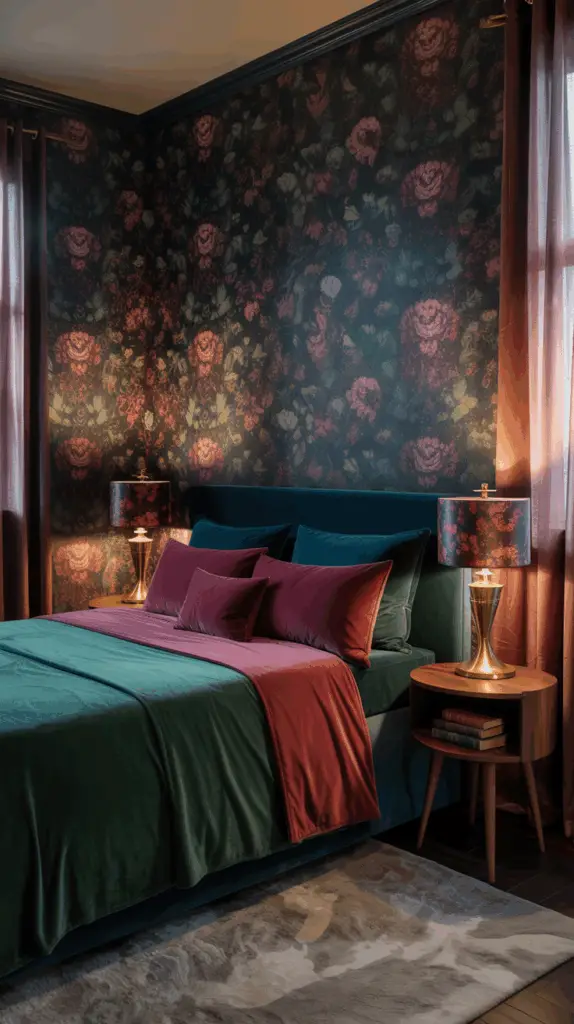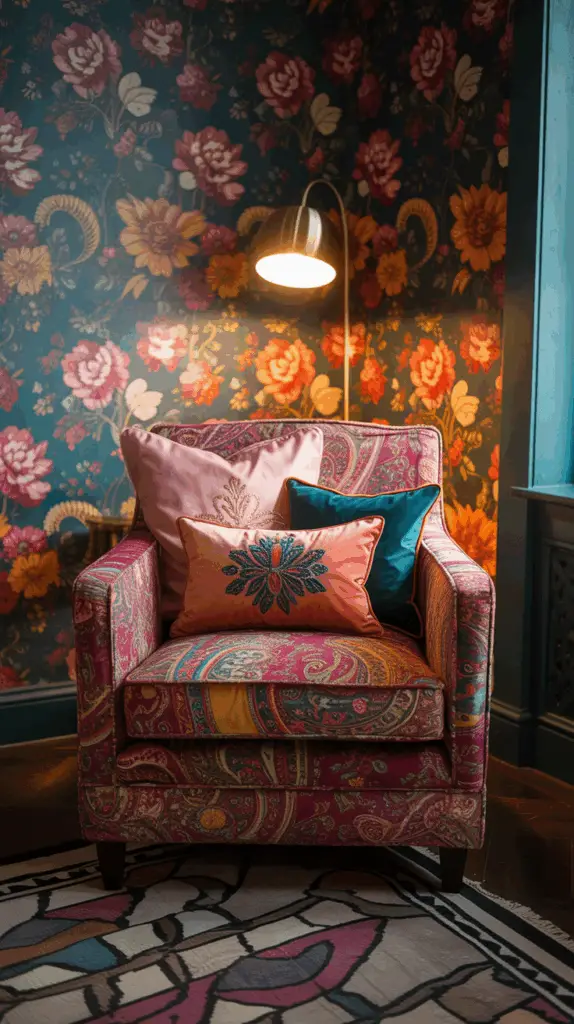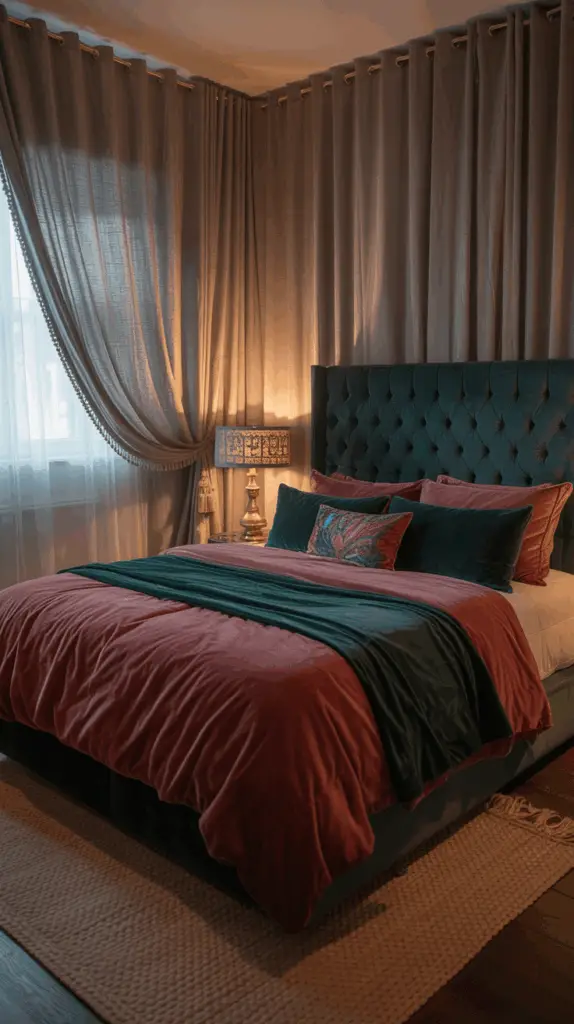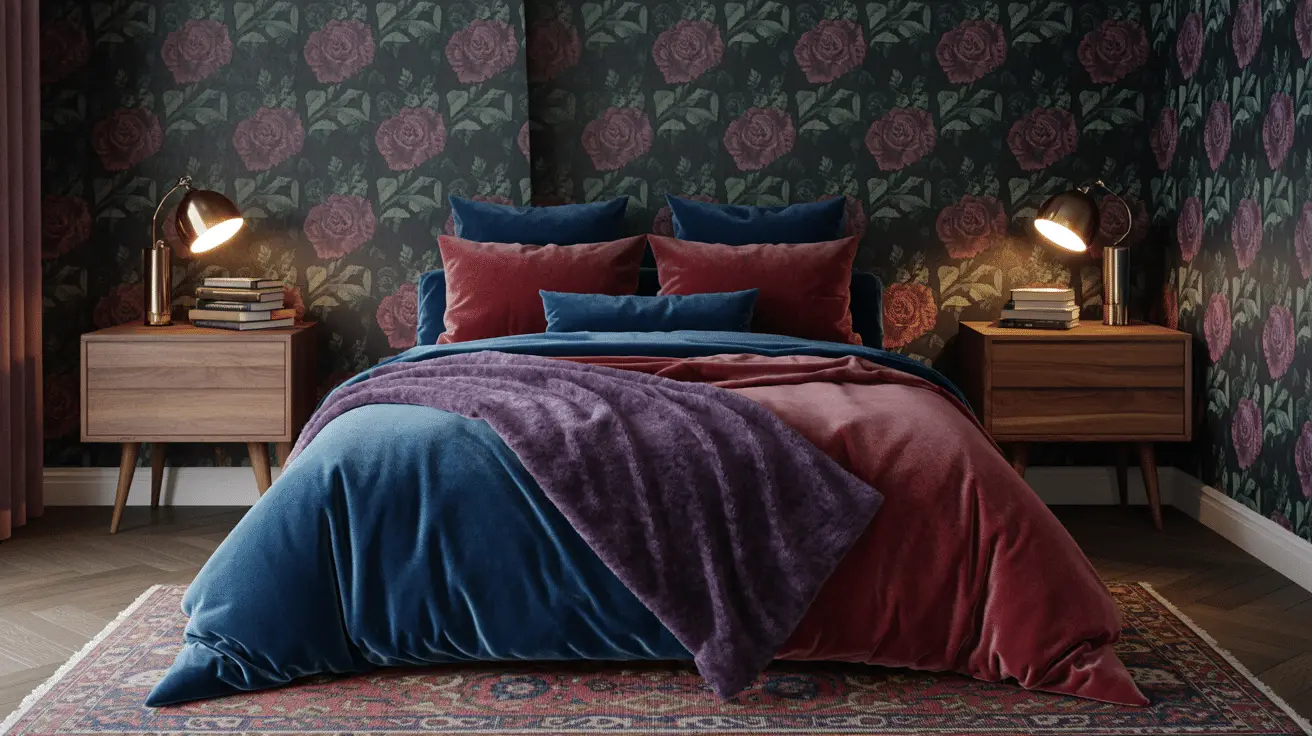Maximalist Small Bedroom Design with Bold Pattern Play for Stylish Impact
Table of Contents
Introduction:
Can a small bedroom handle big style? Absolutely. In fact, some of the most stunning maximalist interiors are born from the tightest corners—where creativity is a necessity, not a luxury. If you’ve ever worried that bold colors or mixed prints might shrink your already modest room, this guide will change your perspective.
Maximalism isn’t about clutter—it’s about intentional layering, vibrant character, and daring visual choices. When executed with care, a maximalist design can transform even the smallest bedroom into a highly personal retreat that feels curated, cozy, and full of charm.
In this post, we’ll dive deep into how to achieve a maximalist small room design using bold pattern play. You’ll learn how to mix prints without visual chaos, where to apply contrast for balance, and how to use texture and color to expand your space visually. Whether you’re updating a tiny apartment bedroom or looking to revamp your guest room, this guide offers practical techniques and inspirational styling ideas to help you embrace big design in a small footprint.
Start with a Pattern-Forward Anchor Piece
In any small space, what you lead with matters. Choosing a dominant pattern to anchor your room sets the tone and becomes your visual guidepost. Whether it’s a floral upholstered headboard, an art deco wallpaper, or a patterned duvet, this piece should reflect your desired energy and color palette.
Let your anchor piece feature bold contrasts or intricate detail. A velvet quilt with a baroque floral motif, for instance, brings in both texture and print, laying a foundation for layering. Use it to dictate the rest of your room’s style—coordinate throw pillows, wall art, or curtains to echo colors or patterns in that initial choice.
Key Tips:
- Choose a dominant pattern with 2–3 key colors.
- Balance intricate patterns with solid blocks of color on walls or floors.
- Use your anchor to inform all secondary design elements.
Visual Breakdown: Selecting Your Anchor Piece
| Anchor Type | Example | Best Paired With |
| Wallpaper (bold print) | Tropical botanical in green | Neutral bedding and solid curtains |
| Upholstered Headboard | Geometric velvet in navy | Monochrome walls, striped pillows |
| Statement Bedding | Baroque floral quilt | Solid rug, minimal nightstands |

Mix Patterns with Purpose, Not Randomness
One of the biggest myths about maximalism is that it’s chaotic. In reality, the most successful pattern mixing is deliberate and strategic. The key lies in variation—scale, style, and spacing.
Start by varying the scale of your patterns. Pair a large botanical wallpaper with mid-sized gingham curtains and a small-scale geometric throw. Then play with complementary motifs—stripes with florals, checks with animal prints. The trick is to find at least one element that ties them all together, whether it’s color, tone, or texture.
Layering patterns also requires mindful spacing. Use negative space to prevent overstimulation. White walls, a clean-lined dresser, or an unpatterned rug can act as breathing room for the eye.
Pattern Mixing Matrix
| Pattern 1 | Pattern 2 | Connector Element |
| Large floral wallpaper | Small gingham throw | Shared warm undertone |
| Leopard print pillow | Wide navy stripe duvet | Both use dark outlines |
| Moroccan rug | Geometric wallpaper | Matching shape repetition |

Layer Texture to Soften the Boldness
Texture is the secret sauce in maximalist design. In a small room filled with busy prints and vivid hues, tactile elements can balance out the visual intensity and create a sense of comfort. Think plush velvets, tufted headboards, linen curtains, woven throws, and shaggy rugs.
By layering textures, you introduce depth and warmth. It’s also a clever way to add contrast without introducing new colors or patterns. For instance, a matte-painted wall behind a glossy ceramic lamp creates interest without additional visual noise.
Use contrasting textures in adjacent areas—a velvet chair beside a raw wood nightstand, or a metallic lamp on a textile-draped dresser. This interplay keeps the eye moving and gives each design element its own identity.
Tactile Layering Cheat Sheet
| Texture Type | Best Use in Small Room | Pair With |
| Velvet | Headboards, pillows | Matte wall paint or satin sheets |
| Woven/natural fiber | Rugs, baskets | High-gloss accessories |
| Linen | Curtains, bedding | Bold prints or heavy patterns |

Use Vertical Space for Drama and Function
When floor space is limited, think upward. Maximalist design embraces statement elements, and in a small bedroom, vertical design lets you make a statement without sacrificing function. Consider tall bookshelves, dramatic drapes hung close to the ceiling, or an oversized art piece above the bed.
Tall elements elongate the room visually and draw the eye upward, creating the illusion of space. Bonus: vertical storage also reduces clutter, which keeps a maximalist room feeling curated rather than crowded.
Designing vertically is also a chance to layer patterns. Hang multiple framed prints in a gallery wall arrangement, or mix and match wallpaper on the upper and lower halves of your walls for a surprising yet cohesive effect.
Vertical Styling Guide
| Vertical Element | Function | Maximalist Twist |
| Ceiling-high curtains | Visually extend wall height | Choose bold prints or luxe fabric |
| Stacked wall shelving | Storage without bulk | Paint in contrasting accent color |
| Tall floor lamp | Light + height | Go sculptural or metallic |
Incorporate Statement Lighting as Visual Anchors
Lighting isn’t just functional—it can be your room’s jewel. In a maximalist bedroom, lighting fixtures can be used to introduce pattern, texture, and even sculptural form. Go for pendant lamps with etched glass, bold-colored ceramic bases, or chandeliers with intricate arms.
For small bedrooms, wall sconces or pendant lights free up surface space while offering dramatic impact. Think of lighting as another layer of the room’s visual identity. Match a boldly patterned lamp shade to a pillow, or let a brass fixture echo your curtain rod’s finish.
Dimmer switches and layered lighting (ambient, task, accent) will make your bold designs glow without overwhelming.
Statement Lighting Selection Table
| Light Fixture Type | Best Location | Design Tip |
| Sconce | Bedside or above art | Match metal tone to other accents |
| Pendant | Above nightstand/bed | Choose unexpected shape or color |
| Table lamp | Dresser or side table | Use printed or colored shade |
Design with Symmetry to Ground the Eclectic Look
Maximalism thrives on contrast, but balance brings harmony. In small rooms, visual symmetry can prevent the space from feeling chaotic. This doesn’t mean everything must match—but consider mirroring nightstands, aligned artwork, or matching lamps to introduce rhythm.
By repeating certain elements across the room—whether it’s shape, scale, or spacing—you build visual stability. That stability allows you to go bolder with color or pattern elsewhere.
Symmetry also aids function in small spaces, as mirrored furniture arrangements naturally optimize flow and storage.
Symmetry Guide for Small Bedrooms
| Element to Mirror | Benefits | Maximalist Approach |
| Nightstands + Lamps | Creates visual order | Use mismatched patterns in same color |
| Artwork above bed | Frames focal point cleanly | Mix print sets in identical frames |
| Pillows and Bedding | Enhances restful look | Pair wild prints with classic shapes |
Conclusion:
Maximalist small bedroom design isn’t about overwhelming the senses—it’s about artfully curating color, pattern, and personality in a compact space. When you begin with a strong anchor, layer patterns with precision, and soften your palette with textures, the room becomes more than a place to sleep—it becomes a sensory experience.
By thinking vertically, leveraging symmetry, and using statement lighting, you elevate the design from merely eclectic to masterfully composed. With the right design lens, a small bedroom is not a limitation—it’s a canvas for bold expression.
So dare to embrace the mix. Because in a small space, more can truly be more—when done right.

